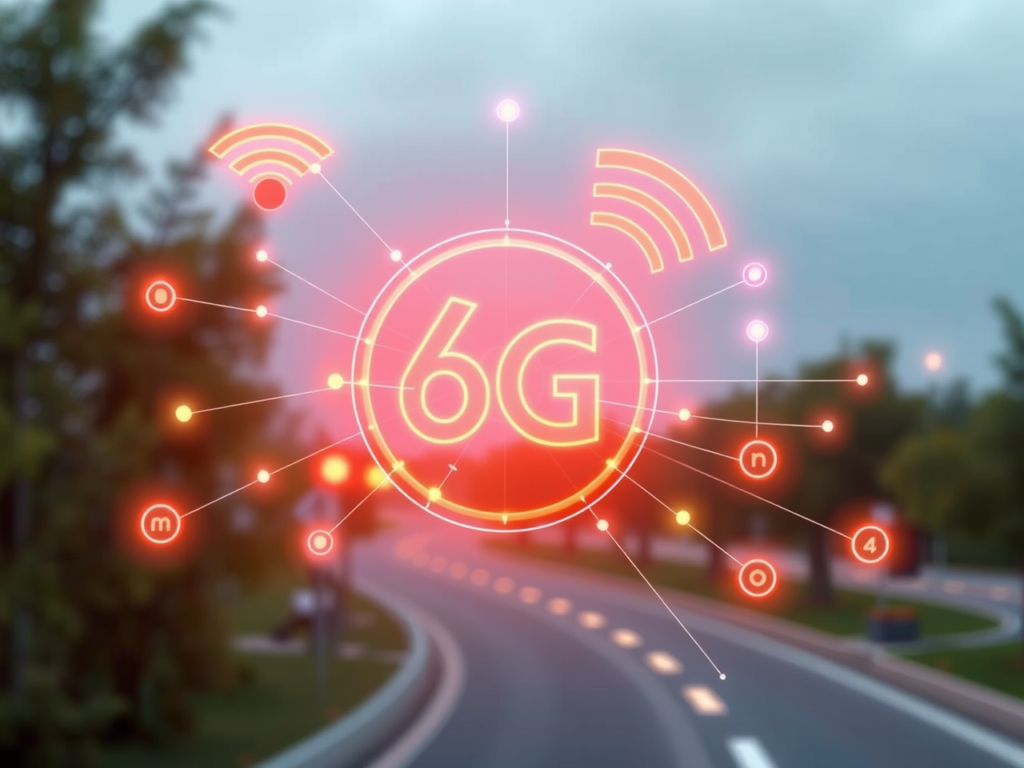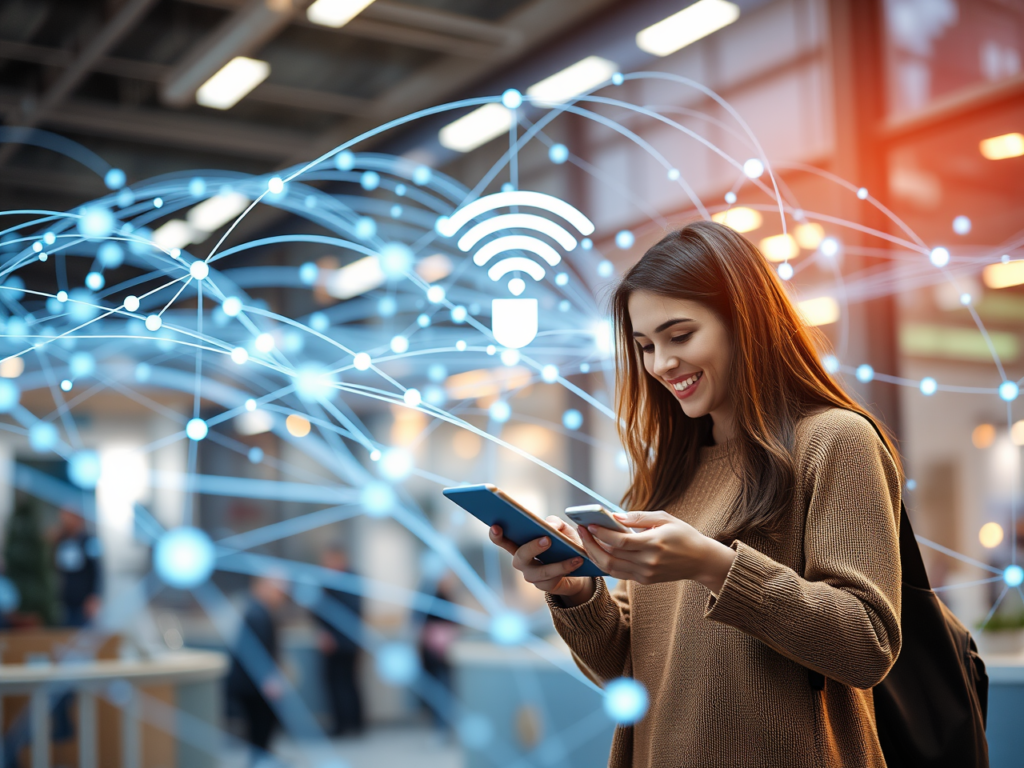The Future of Wireless Communication
Wifi is a common word these days. You move into villages in India and you would definitely find kids who are aware of what Wifi is at least as far as using the internet is concerned. Back in the days we used to wonder how Wifi worked, what was new in 3G than in 2G. Times have changed drastically and in today’s fast-paced digital world, the demand for faster and more reliable communication networks has grown exponentially. We are moving towards a future where “zero latency connectivity” is becoming the cornerstone of innovation in various fields, including virtual reality, autonomous vehicles, smart cities, and healthcare. Zero latency, in essence, refers to the absence of noticeable delay in the transmission of data between devices, users, or systems. This seamless communication capability is critical for enabling real-time applications, ensuring quick responses, and maintaining data accuracy in mission-critical scenarios.
The advent of wireless low-power networks, the development of 6G cellular technology, advancements in Wi-Fi 6 and 7, and the proliferation of low-Earth orbit (LEO) satellites are revolutionizing our current understanding of connectivity. These technologies not only promise faster internet speeds but also lower latency, enhanced energy efficiency, and greater reliability, which are crucial for the realization of zero latency connectivity.
As we progress toward a more connected society, the need for ultra-fast, low-latency communication is driving significant research and development efforts. Next-generation technologies, such as 6G and Wi-Fi 7, along with the deployment of satellite networks in low-Earth orbit, are being designed to reduce communication delays to near zero. These innovations are expected to power future digital ecosystems where data is transferred instantly, enabling groundbreaking advancements across industries.
Table of Contents
The Future of Wireless Communication.
The Evolution of Wireless Low-Power Networks.
Role in Achieving Zero Latency.
Wi-Fi 6 and 7: The Future of High-Speed Wireless.
Wi-Fi 7: Pushing the Boundaries of Zero Latency.
Low-Earth Orbit Satellites: Expanding Global Connectivity.
The Importance of Edge Computing in Reducing Latency.
Real-World Applications of Zero Latency Connectivity.
Challenges in Achieving Zero Latency Connectivity.
Comparison Charts of 6G and Other Emerging Technologies with Existing Ones.
This article will explore the components contributing to zero latency connectivity, including wireless low-power networks, 6G cellular, Wi-Fi 6 and 7, and low-Earth orbit satellites. We will discuss their potential to transform industries, their role in supporting real-time applications, and the challenges involved in achieving true zero latency. As technology continues to evolve, zero latency connectivity is no longer a distant dream but an achievable reality that will shape the future of communication and innovation.
The Evolution of Wireless Low-Power Networks
Wireless low-power networks (WLPNs) are at the forefront of enabling zero latency connectivity, particularly in the context of the Internet of Things (IoT) and machine-to-machine (M2M) communication. These networks are designed to offer wireless communication with minimal power consumption, making them ideal for a wide range of applications, from smart homes to industrial automation.
What Are Wireless Low-Power Networks?
WLPNs are networks that allow devices to communicate wirelessly while using very little energy. These networks are specifically designed for devices that operate on battery power, enabling them to function for extended periods without frequent recharging. In contrast to traditional wireless networks, which often prioritize speed and bandwidth, WLPNs emphasize efficiency, range, and low latency to support real-time data transmission across a broad area.

Role in Achieving Zero Latency
The significance of WLPNs in achieving zero latency lies in their ability to support low-power IoT devices that require real-time communication. In applications such as autonomous vehicles or healthcare monitoring, where data must be transferred instantly, WLPNs enable devices to communicate quickly and efficiently with minimal delay. The low power consumption also ensures that the networks remain operational over long periods, reducing the need for constant maintenance and ensuring continuous connectivity.
6G Cellular Technology: The Next Frontier
The evolution of cellular networks is a key driver of zero latency connectivity. While 5G technology has already made significant strides in reducing latency and increasing speeds, the upcoming 6G networks are expected to take these advancements to the next level.
What is 6G?
6G is the next generation of wireless technology, expected to launch in the 2030s. It is designed to offer speeds that are up to 100 times faster than 5G, with the potential for latency as low as one microsecond (1 µs). This would bring us closer to achieving zero latency, making real-time communication between devices virtually instantaneous.

One of the core advancements in 6G is its use of terahertz frequencies, which are significantly higher than the frequencies used by 5G. These higher frequencies allow for faster data transmission, but they also require new infrastructure and technologies to support them.
How 6G Will Enable Zero Latency
The move towards 6G is not just about faster speeds, but about enabling real-time applications that demand zero latency. Autonomous systems, such as self-driving cars and drones, will require instant communication to ensure safety and efficiency. 6G’s ultra-low latency capabilities will make this possible, enabling machines to react in real time without any noticeable delay.
Moreover, 6G is expected to enhance the capacity for machine-to-machine (M2M) communication, facilitating the seamless operation of interconnected devices. For industries such as manufacturing and healthcare, this could mean significant advancements in automation, remote surgeries, and smart infrastructure, all powered by zero latency networks.
Wi-Fi 6 and 7: The Future of High-Speed Wireless
Wi-Fi technology has also seen rapid evolution, with Wi-Fi 6 and the upcoming Wi-Fi 7 technologies being designed to meet the growing demand for faster, more reliable wireless connectivity. These advancements in Wi-Fi are pivotal for reducing latency in everyday applications.
Wi-Fi 6: A Step Towards Low Latency
Wi-Fi 6, also known as 802.11ax, is the latest iteration of Wi-Fi technology and offers several improvements over its predecessor, Wi-Fi 5. While previous Wi-Fi standards primarily focused on increasing speed, Wi-Fi 6 is designed with latency in mind, offering a more responsive and efficient wireless network.
Wi-Fi 6 uses orthogonal frequency-division multiple access (OFDMA) technology, which divides a Wi-Fi channel into smaller sub-channels, allowing multiple devices to share the same channel without interference. This leads to reduced congestion, particularly in environments with many connected devices, such as smart homes or offices. With Wi-Fi 6, latency is significantly lower, making real-time communication between devices more seamless.
Wi-Fi 7: Pushing the Boundaries of Zero Latency
Wi-Fi 7, or 802.11be, is the upcoming standard that promises to further reduce latency while increasing speed and capacity. Expected to be released in the coming years, Wi-Fi 7 will offer speeds of up to 30 Gbps, making it a perfect candidate for zero latency connectivity. The introduction of multi-link operation (MLO) in Wi-Fi 7 will allow devices to use multiple frequency bands simultaneously, further reducing latency and improving network reliability.
Wi-Fi 7’s capabilities will be particularly beneficial in environments that require high-speed, real-time communication, such as virtual reality (VR), augmented reality (AR), and gaming. As applications like the metaverse and remote collaboration tools continue to evolve, the demand for low-latency Wi-Fi will only increase, making Wi-Fi 7 a critical component of the zero latency future.
Low-Earth Orbit Satellites: Expanding Global Connectivity
Low-Earth orbit (LEO) satellites are another key enabler of zero latency connectivity, particularly in areas where traditional terrestrial networks are unavailable or insufficient. LEO satellites are positioned closer to the Earth’s surface than traditional geostationary satellites, reducing the time it takes for data to travel between the satellite and the Earth.

How LEO Satellites Work
LEO satellites orbit the Earth at an altitude of around 1,200 miles, compared to geostationary satellites that orbit at 22,000 miles. This proximity allows LEO satellites to provide faster communication with much lower latency. LEO satellite networks, such as SpaceX’s Starlink, are being designed to offer global high-speed internet access with latency as low as 20 milliseconds.
The Role of LEO Satellites in Zero Latency Connectivity
LEO satellite networks are particularly important for achieving zero latency connectivity in remote or underserved areas where traditional network infrastructure is lacking. By providing low-latency communication to these regions, LEO satellites can enable real-time applications that were previously impossible due to slow or unreliable internet connections.
For industries like agriculture, where connected devices and sensors are increasingly being used to monitor crops and livestock, low-latency communication via LEO satellites could lead to more efficient and precise farming practices. Similarly, in disaster response scenarios, LEO satellites can provide instant communication and coordination between rescue teams, potentially saving lives in critical situations.
The Importance of Edge Computing in Reducing Latency
While advancements in wireless and satellite technology are essential for achieving zero latency connectivity, the role of edge computing cannot be overlooked. Edge computing refers to the practice of processing data closer to where it is generated, rather than relying on distant cloud servers.
How Edge Computing Reduces Latency
In traditional cloud computing, data must travel long distances to reach a centralized server, introducing delays. Edge computing, on the other hand, brings the computation and data storage closer to the devices themselves, significantly reducing the time it takes for data to be processed and transmitted. This is particularly important for applications that require real-time responses, such as autonomous vehicles and smart infrastructure.
Edge Computing and Zero Latency
By processing data locally, edge computing can help achieve zero latency in scenarios where immediate decision-making is critical. For example, in a smart factory, sensors and robots must communicate in real-time to ensure smooth and efficient operations. Edge computing allows these devices to process and share data instantly, eliminating the delays associated with cloud-based processing.
Moreover, the combination of edge computing and low-latency wireless networks, such as 6G and Wi-Fi 7, will enable the seamless operation of real-time applications across industries. From healthcare to logistics, edge computing will play a crucial role in realizing the potential of zero latency connectivity.
Real-World Applications of Zero Latency Connectivity
As zero latency connectivity becomes a reality, its applications across various industries are expected to grow exponentially. The following are some of the key sectors that stand to benefit from ultra-fast, low-latency communication:
Autonomous Vehicles
Autonomous vehicles rely on real-time communication with other vehicles, infrastructure, and sensors to navigate safely. Zero latency connectivity will enable instant decision-making, allowing vehicles to respond to changing conditions without any delay. This could lead to safer roads, reduced traffic congestion, and more efficient transportation systems.
Healthcare
In healthcare, zero latency connectivity could revolutionize telemedicine and remote surgeries. Surgeons will be able to perform operations remotely with precision, thanks to real-time communication between medical devices and robotic systems. Additionally, wearable devices and sensors will be able to transmit patient data instantly, enabling doctors to monitor health conditions in real-time and provide immediate treatment when necessary.
Gaming and Entertainment
The gaming industry is another sector that will greatly benefit from zero latency connectivity. Gamers demand fast, responsive networks that allow for seamless gameplay, particularly in competitive environments. With zero latency, online gaming experiences will become smoother and more immersive, and technologies such as cloud gaming will see significant improvements.
Industry 4.0 and Smart Factories
In the context of Industry 4.0, zero latency connectivity will enable factories to become fully automated and self-sufficient. Machines, robots, and sensors will communicate in real-time, ensuring efficient and precise manufacturing processes. This will lead to reduced downtime, lower operational costs, and higher productivity.
Challenges in Achieving Zero Latency Connectivity
While the vision of zero latency connectivity is exciting, several challenges must be addressed to make it a reality.
Infrastructure Development
Building the infrastructure to support 6G, Wi-Fi 7, and LEO satellites is a complex and costly process. These networks require new hardware, software, and regulatory frameworks to function efficiently. Additionally, the deployment of edge computing infrastructure will be necessary to reduce latency in data processing.
Spectrum Allocation
The higher frequencies used by 6G and Wi-Fi 7 require more spectrum, which is a limited resource. Governments and regulatory bodies will need to allocate and manage this spectrum carefully to ensure that there is enough bandwidth for new technologies while avoiding interference with existing networks.
Security and Privacy Concerns
As zero latency connectivity enables real-time data transmission, concerns about data security and privacy will become more prominent. Protecting sensitive data from cyberattacks and ensuring secure communication between devices will be critical for maintaining trust in zero latency networks.
Comparison Charts of 6G and Other Emerging Technologies with Existing Ones
The comparison charts below will highlight the advancements in key technologies, focusing on parameters like speed, latency, connectivity, and power consumption, demonstrating how 6G, Wi-Fi 6/7, LEO satellites, and wireless low-power networks surpass their predecessors.

1. Cellular Network Comparison: 4G vs 5G vs 6G
| Feature | 4G | 5G | 6G |
| Max Data Speed | 1 Gbps | 10-20 Gbps | 100-1000 Gbps |
| Latency | ~50 ms | ~1-10 ms | <1 ms (as low as 1 µs) |
| Spectrum | Sub-6 GHz | Sub-6 GHz, mmWave | mmWave, Terahertz (THz) |
| Connection Density | 100,000/km² | 1,000,000/km² | 10,000,000/km² |
| Use Cases | HD streaming, Voice | Enhanced mobile broadband, IoT | Holographic communication, XR, AI-powered applications |
| Energy Efficiency | Moderate | Higher than 4G | Significantly better than 5G |
| Key Innovation | LTE | Massive MIMO, Beamforming | AI-Driven Networks, Quantum Communication |
| Commercial Availability | Widely available | Currently available in some areas | Expected around 2030 |
2. Wi-Fi Technology Comparison: Wi-Fi 5 vs Wi-Fi 6 vs Wi-Fi 7
| Feature | Wi-Fi 5 (802.11ac) | Wi-Fi 6 (802.11ax) | Wi-Fi 7 (802.11be) |
| Max Speed | 3.5 Gbps | 9.6 Gbps | 30 Gbps |
| Latency | ~30-50 ms | ~10 ms | <1 ms |
| Frequency Bands | 5 GHz | 2.4 GHz, 5 GHz, 6 GHz | 2.4 GHz, 5 GHz, 6 GHz |
| Channel Width | 80 MHz | 160 MHz | 320 MHz |
| Multi-Link Operation (MLO) | No | No | Yes |
| OFDMA (Frequency Multiplexing) | No | Yes | Enhanced OFDMA |
| Target Wake Time (TWT) | No | Yes | Improved TWT |
| Key Application | HD Streaming | IoT, Low-Latency Apps | VR, AR, High-bandwidth AI Apps |
| Power Efficiency | Moderate | More efficient than Wi-Fi 5 | Highest efficiency |
3. Satellite Internet Comparison: Geostationary Satellites vs Low-Earth Orbit (LEO) Satellites
| Feature | Geostationary Satellites | LEO Satellites |
| Altitude | 35,786 km | 160-2,000 km |
| Latency | 500-600 ms | 20-40 ms |
| Data Speed | 100 Mbps | 1 Gbps or higher |
| Coverage | Global | Global, but more uniform |
| Infrastructure | Requires fewer satellites | Requires thousands of satellites |
| Applications | Broadcast TV, Satellite Phones | Broadband Internet, IoT, Real-time communication |
| Deployment Cost | High (few satellites needed) | Lower (due to mass deployment) |
| Reliability | Susceptible to weather delays | More reliable in low-latency scenarios |
| Use Cases | Broadcasting | Remote areas, Disaster recovery, Low-latency services |
4. Wireless Low-Power Networks (WLPN) Comparison: Zigbee vs LoRaWAN vs NB-IoT
| Feature | Zigbee | LoRaWAN | NB-IoT |
| Range | 10-100 meters | Up to 10 km | Up to 40 km |
| Data Rate | 20-250 kbps | 0.3-50 kbps | 100 kbps |
| Latency | 30-100 ms | ~200 ms | ~1.6-10 seconds |
| Power Consumption | Low | Very low | Low |
| Frequency Band | 2.4 GHz | Sub-GHz (868/915 MHz) | Licensed Spectrum (800/900 MHz) |
| Network Size | Small (up to 65,000 devices) | Large (thousands of devices) | Large (up to 100,000 devices) |
| Use Cases | Smart Home, Wearables | Agriculture, Smart Cities | Industry 4.0, Utilities, Healthcare |
| Battery Life | Months | 10+ Years | 10+ Years |
| Deployment Type | Mesh Network | Star Topology | Star Topology |
5. Edge Computing vs Cloud Computing
| Feature | Cloud Computing | Edge Computing |
| Latency | High (due to distant servers) | Low (data processed closer to device) |
| Data Processing Location | Centralized Data Centers | At the network edge (closer to users) |
| Response Time | Slower (depending on server location) | Near-instantaneous for critical tasks |
| Ideal Use Cases | Data storage, AI/ML Training | Real-time applications like Autonomous Vehicles, IoT, AR/VR |
| Bandwidth Usage | High (large data transfer to cloud) | Lower (local processing) |
| Security | Centralized (vulnerable to breaches) | Localized, less exposure to external threats |
| Scalability | Easier to scale with server infrastructure | More complex to scale across distributed devices |
| Cost Efficiency | Pay-as-you-go model | Can reduce data transfer costs, but hardware investments required |
| Reliability | Dependent on internet connection | More reliable in remote locations |
| Energy Consumption | Higher | Lower (due to localized processing) |
6. Comparison of Latency and Speed in Communication Technologies
| Technology | Max Data Rate | Latency | Best Use Case |
| 4G LTE | 1 Gbps | 50 ms | Mobile internet, Video streaming |
| 5G | 10-20 Gbps | 1-10 ms | Enhanced mobile broadband, IoT |
| 6G | 100-1000 Gbps | <1 ms (as low as 1 µs) | Autonomous systems, AR/VR, AI |
| Wi-Fi 5 | 3.5 Gbps | 30-50 ms | Home and office networks |
| Wi-Fi 6 | 9.6 Gbps | 10 ms | Smart homes, IoT, Low-latency apps |
| Wi-Fi 7 | 30 Gbps | <1 ms | AR/VR, High-bandwidth AI applications |
| LEO Satellites | 1 Gbps or higher | 20-40 ms | Remote internet access, IoT, Disaster relief |
| Geostationary Satellites | 100 Mbps | 500-600 ms | Satellite broadcasting, Satellite phones |
| Zigbee (Low Power Network) | 250 kbps | 30-100 ms | Smart homes, Wearables |
| LoRaWAN (Low Power Network) | 50 kbps | ~200 ms | Smart cities, Agriculture |
| NB-IoT (Low Power Network) | 100 kbps | ~1.6-10 seconds | Industrial IoT, Utilities, Smart metering |
These comparison charts and tables demonstrate the significant advancements in latency, speed, coverage, and energy efficiency brought by next-generation technologies like 6G, Wi-Fi 7, LEO satellites, and wireless low-power networks. Each innovation addresses the growing need for faster, more reliable, and energy-efficient communication, propelling us toward a future of zero latency connectivity.
Conclusion
Zero latency connectivity is poised to revolutionize the way we live and work, enabling real-time applications that were once thought to be science fiction. Wireless low-power networks, 6G cellular, Wi-Fi 6 and 7, LEO satellites, and edge computing are all playing critical roles in bringing this vision to life. While challenges remain, the progress being made in reducing latency is undeniable, and the future of communication looks brighter than ever. As these technologies continue to evolve, zero latency connectivity will become the foundation for the digital ecosystems of tomorrow, driving innovation across industries and improving the quality of life for people around the world.
Best Reads:






This was beautiful Admin. Thank you for your reflections.